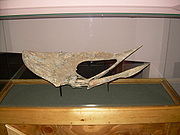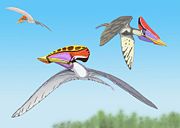
Tupuxuara
Encyclopedia
Tupuxuara is a genus
of large, crested, toothless pterodactyloid
pterosaur
.
The genus was in 1988 named and described by Alexander Kellner
and Diogenes de Almeida Campos. The type species
is Tupuxuara longicristatus. The genus name refers to a familiar spirit
from the mythology
of the Tupi. The specific name means "long-crested" in Latin
.
 The holotype
The holotype
, MN 6591-V, was found in the Cretaceous
Santana Formation
of Brazil. It consists of a snout and some partial wing bones. Mature individuals of T. longicristatus had a back-swept crest arising from the snout. Much more fossil material has later been found, showing considerable variation in morphology
. Some researchers explain this as intra-specific variability, being caused by a difference in age or sex. Others, however, assume there are different species present.
In 1994 a second species was named by Kellner: Tupuxuara leonardii. The specific name honours Giuseppe Leonardi. The holotype is MN 6592-V, a fragmentary skull with a more rounded crest. Other such material has been referred to T. leonardii. The largest skulls have a length of 130 centimetres indicating a wingspan of 5.5 meters.
In 2009 a third species was named, by Mark Paul Witton: Tupuxuara deliridamus. The holotype is SMNK PAL 6410, a skull. Another skull is the paratype
: KPMNH DL 84. The specific name is derived from Latin delirus, "insane" or "crazy", and adamas, "invincible" but also the word from which "diamond" is derived. The species has a distinctive diamond-shaped skull opening and low eye sockets. The name is a tribute to the song "Shine On You Crazy Diamond
" by Pink Floyd
, one of Witton's favourite bands.
 Tupuxuara is a member of the group Azhdarchoidea
Tupuxuara is a member of the group Azhdarchoidea
. Kellner assigned it to the Tapejaridae
within Azhdarchoidea. According to some analyses however, Tupuxuara is closer to the Azhdarchidae
(the group that includes the giant Texan form Quetzalcoatlus
) than to Tapejara and its relatives.
It has been suggested that Tupuxuara was a fish eater at the coasts of South America
. Other hypotheses include the possibility it was a fruit eater.
A subadult described by David Martill and Darren Naish
from the University of Portsmouth
in 2006 had not yet fully developed its crest, which supports the suggestion that the crest was a marker for sexual maturity.
Comparisons between the scleral ring
s of Tupuxuara and modern birds and reptiles suggest that it may have been diurnal.
Genus
In biology, a genus is a low-level taxonomic rank used in the biological classification of living and fossil organisms, which is an example of definition by genus and differentia...
of large, crested, toothless pterodactyloid
Pterodactyloidea
Pterodactyloidea forms one of the two suborders of pterosaurs , and contains the most derived members of this group of flying reptiles...
pterosaur
Pterosaur
Pterosaurs were flying reptiles of the clade or order Pterosauria. They existed from the late Triassic to the end of the Cretaceous Period . Pterosaurs are the earliest vertebrates known to have evolved powered flight...
.
The genus was in 1988 named and described by Alexander Kellner
Alexander Kellner
Alexander Wilhelm Armin Kellner is a Liechtensteinian/Brazilian paleontologist, a leading expert in the field of the study of pterosaurs....
and Diogenes de Almeida Campos. The type species
Type species
In biological nomenclature, a type species is both a concept and a practical system which is used in the classification and nomenclature of animals and plants. The value of a "type species" lies in the fact that it makes clear what is meant by a particular genus name. A type species is the species...
is Tupuxuara longicristatus. The genus name refers to a familiar spirit
Familiar spirit
In European folklore and folk-belief of the Medieval and Early Modern periods, familiar spirits were supernatural entities believed to assist witches and cunning folk in their practice of magic...
from the mythology
Mythology
The term mythology can refer either to the study of myths, or to a body or collection of myths. As examples, comparative mythology is the study of connections between myths from different cultures, whereas Greek mythology is the body of myths from ancient Greece...
of the Tupi. The specific name means "long-crested" in Latin
Latin
Latin is an Italic language originally spoken in Latium and Ancient Rome. It, along with most European languages, is a descendant of the ancient Proto-Indo-European language. Although it is considered a dead language, a number of scholars and members of the Christian clergy speak it fluently, and...
.

Holotype
A holotype is a single physical example of an organism, known to have been used when the species was formally described. It is either the single such physical example or one of several such, but explicitly designated as the holotype...
, MN 6591-V, was found in the Cretaceous
Cretaceous
The Cretaceous , derived from the Latin "creta" , usually abbreviated K for its German translation Kreide , is a geologic period and system from circa to million years ago. In the geologic timescale, the Cretaceous follows the Jurassic period and is followed by the Paleogene period of the...
Santana Formation
Santana Formation
The Santana Formation is a geologic Lagerstätte in northeastern Brazil's Araripe Basin where the states of Pernambuco, Piauí and Ceará come together. The geological formation, named after the village of Santana do Cariri, lies at the base of the Araripe Plateau...
of Brazil. It consists of a snout and some partial wing bones. Mature individuals of T. longicristatus had a back-swept crest arising from the snout. Much more fossil material has later been found, showing considerable variation in morphology
Morphology (biology)
In biology, morphology is a branch of bioscience dealing with the study of the form and structure of organisms and their specific structural features....
. Some researchers explain this as intra-specific variability, being caused by a difference in age or sex. Others, however, assume there are different species present.
In 1994 a second species was named by Kellner: Tupuxuara leonardii. The specific name honours Giuseppe Leonardi. The holotype is MN 6592-V, a fragmentary skull with a more rounded crest. Other such material has been referred to T. leonardii. The largest skulls have a length of 130 centimetres indicating a wingspan of 5.5 meters.
In 2009 a third species was named, by Mark Paul Witton: Tupuxuara deliridamus. The holotype is SMNK PAL 6410, a skull. Another skull is the paratype
Paratype
Paratype is a technical term used in the scientific naming of species and other taxa of organisms. The exact meaning of the term paratype when it is used in zoology is not the same as the meaning when it is used in botany...
: KPMNH DL 84. The specific name is derived from Latin delirus, "insane" or "crazy", and adamas, "invincible" but also the word from which "diamond" is derived. The species has a distinctive diamond-shaped skull opening and low eye sockets. The name is a tribute to the song "Shine On You Crazy Diamond
Shine On You Crazy Diamond
"Shine On You Crazy Diamond" is a nine-part Pink Floyd composition written by Roger Waters, Richard Wright, and David Gilmour. The song is a tribute to former band member Syd Barrett, although it was not originally explicitly written with him in mind. It was first performed on their 1974 French...
" by Pink Floyd
Pink Floyd
Pink Floyd were an English rock band that achieved worldwide success with their progressive and psychedelic rock music. Their work is marked by the use of philosophical lyrics, sonic experimentation, innovative album art, and elaborate live shows. Pink Floyd are one of the most commercially...
, one of Witton's favourite bands.

Azhdarchoidea
Azhdarchoidea is a group of pterosaurs within the suborder Pterodactyloidea.-Classification:Listing of families and genera after Unwin 2006 except where specified.* Superfamily Azhdarchoidea** Genus "Aurorazhdarcho"** Family Chaoyangopteridae...
. Kellner assigned it to the Tapejaridae
Tapejaridae
Tapejaridae are a family of pterodactyloid pterosaurs from the early Cretaceous period. Members are currently known from Brazil and China, where the most primitive genera are found, indicating that the family has an Asian origin....
within Azhdarchoidea. According to some analyses however, Tupuxuara is closer to the Azhdarchidae
Azhdarchidae
Azhdarchidae is a family of pterosaurs known primarily from the late Cretaceous Period, though an isolated vertebrae apparently from an azhdarchid is known from the early Cretaceous as well...
(the group that includes the giant Texan form Quetzalcoatlus
Quetzalcoatlus
Quetzalcoatlus was a pterodactyloid pterosaur known from the Late Cretaceous of North America , and one of the largest known flying animals of all time. It was a member of the Azhdarchidae, a family of advanced toothless pterosaurs with unusually long, stiffened necks...
) than to Tapejara and its relatives.
It has been suggested that Tupuxuara was a fish eater at the coasts of South America
South America
South America is a continent situated in the Western Hemisphere, mostly in the Southern Hemisphere, with a relatively small portion in the Northern Hemisphere. The continent is also considered a subcontinent of the Americas. It is bordered on the west by the Pacific Ocean and on the north and east...
. Other hypotheses include the possibility it was a fruit eater.
A subadult described by David Martill and Darren Naish
Darren Naish
Darren Naish is a vertebrate palaeontologist and science writer. He obtained a geology degree at the University of Southampton and later studied vertebrate palaeontology under British palaeontologist David Martill at the University of Portsmouth, where he obtained both an M. Phil...
from the University of Portsmouth
University of Portsmouth
The University of Portsmouth is a university in Portsmouth, Hampshire, England. The University was ranked 60th out of 122 in The Sunday Times University Guide...
in 2006 had not yet fully developed its crest, which supports the suggestion that the crest was a marker for sexual maturity.
Comparisons between the scleral ring
Sclerotic ring
Sclerotic rings are rings of bone found in the eyes of several groups of vertebrate animals, except for mammals and crocodilians. They can be made up of single bones or small bones together. They are believed to have a role in supporting the eye, especially in animals whose eyes are not spherical,...
s of Tupuxuara and modern birds and reptiles suggest that it may have been diurnal.

